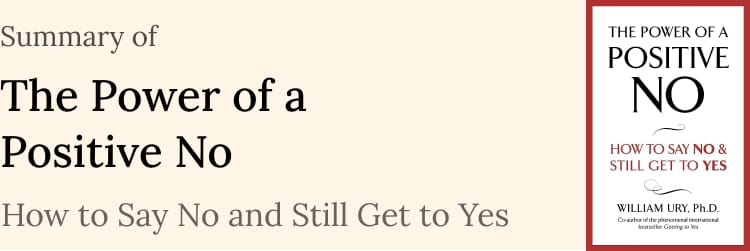- Playtext
- Posts
- The Power of a Positive No
The Power of a Positive No
How to Say No and Still Get to Yes
Hey Players – Here's what we'll learn today:
🚫 Mastering 'No': Stand firm without burning bridges.
💡 Yes-No-Yes Formula: Decline with style and offer alternatives.
❤️ Value Relationships: Say 'No' without losing friends.
🌊 Handle Pushbacks: Stay cool under pressure.
🤝 Empathy Matters: Feel and respect others' vibes.
🌟 Stay True: Always prioritize your true self.
Happy reading!
Book of the Week
"When we say No to what we don’t want, we say Yes to what we do want."
The Power of a Positive No teaches practical techniques for asserting oneself without jeopardizing relationships. The book offers a structured approach to convey a 'No' that is both constructive and affirmative, ensuring personal boundaries are upheld while nurturing relationships. By mastering the art of saying No, individuals can navigate complex interpersonal situations with grace.
Key Principles
1. The Value of No
“No” is a tool for personal integrity.
It's a reflection of one's values, priorities, and boundaries.
Saying No can be empowering and liberating.
It's not a rejection but a clear expression of one's limits.
2. Yes-No-Yes Formula
Yes: Connect with their needs and interests.
“This restaurant seems fantastic, and I would love to hang out.”
No: Convey your refusal clearly but with respect.
"I appreciate the invite, but I can't make it tonight."
Yes: Propose an alternative or offer a positive counter-solution.
"How about we meet for brunch tomorrow instead?"
3. Respect the Relationship
Separate the person from the request when saying No.
Ensure they feel valued and heard.
Convey appreciation for their understanding.
Reiterate the importance of the relationship despite the refusal.
4. Prepare for Resistance
Anticipate potential objections or counterarguments.
Reaffirm your reasons without becoming confrontational.
Offer explanations, not excuses.
Stay calm and composed, even if the other party becomes emotional.
5. The Power of Empathy
Strive to understand the other's perspective.
Acknowledge their feelings and needs.
Express genuine regret if the situation warrants it.
Remember that empathy can bridge the gap of disagreement.
6. Stay True to Yourself
Recognize when compliance would lead to personal compromise.
Reflect on past instances where not saying No led to regret.
Prioritize self-respect over momentary discomfort.
Remember that every No can be a Yes to something more aligned with your values.
Top Articles
A roundup of the week's most popular articles and essays from Playtext.
Notes
Want to read more books? Go to Playtext Books and explore 100+ books on Business, Science, and Productivity.
Reading too many articles? Playtext turns Articles into Audiobooks so you can read 3x faster!
Have a book recommendation? Reply to this email with the book you want to read. We are always looking for great books to read (:
How did you like today's newsletter?Feedback is a gift. |
